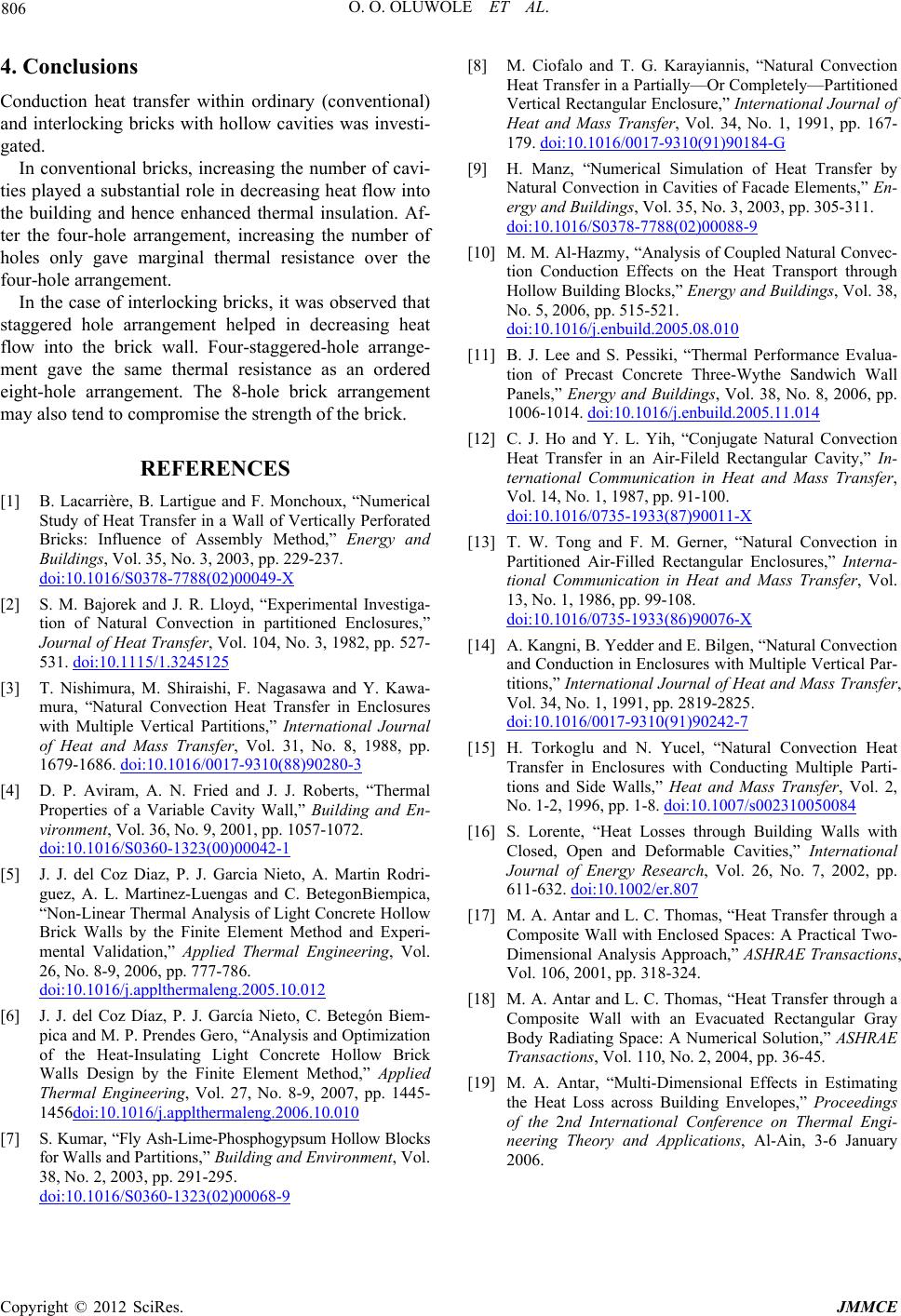
O. O. OLUWOLE ET AL.
806
4. Conclusions
Conduction heat transfer within ordinary (conventional)
and interlocking bricks with hollow cavities was investi-
gated.
In conventional bricks, increasing the number of cavi-
ties played a substantial role in decreasing heat flow into
the building and hence enhanced thermal insulation. Af-
ter the four-hole arrangement, increasing the number of
holes only gave marginal thermal resistance over the
four-hole arrangement.
In the case of interlocking bricks, it was observed that
staggered hole arrangement helped in decreasing heat
flow into the brick wall. Four-staggered-hole arrange-
ment gave the same thermal resistance as an ordered
eight-hole arrangement. The 8-hole brick arrangement
may also tend to compromise the strength of the brick.
REFERENCES
[1] B. Lacarrière, B. Lartigue and F. Monchoux, “Numerical
Study of Heat Transfer in a Wall of Vertically Perforated
Bricks: Influence of Assembly Method,” Energy and
Buildings, Vol. 35, No. 3, 2003, pp. 229-237.
doi:10.1016/S0378-7788(02)00049-X
[2] S. M. Bajorek and J. R. Lloyd, “Experimental Investiga-
tion of Natural Convection in partitioned Enclosures,”
Journal of Heat Transfer, Vol. 104, No. 3, 1982, pp. 527-
531. doi:10.1115/1.3245125
[3] T. Nishimura, M. Shiraishi, F. Nagasawa and Y. Kawa-
mura, “Natural Convection Heat Transfer in Enclosures
with Multiple Vertical Partitions,” International Journal
of Heat and Mass Transfer, Vol. 31, No. 8, 1988, pp.
1679-1686. doi:10.1016/0017-9310(88)90280-3
[4] D. P. Aviram, A. N. Fried and J. J. Roberts, “Thermal
Properties of a Variable Cavity Wall,” Building and En-
vironment, Vol. 36, No. 9, 2001, pp. 1057-1072.
doi:10.1016/S0360-1323(00)00042-1
[5] J. J. del Coz Diaz, P. J. Garcia Nieto, A. Martin Rodri-
guez, A. L. Martinez-Luengas and C. BetegonBiempica,
“Non-Linear Thermal Analysis of Light Concrete Hollow
Brick Walls by the Finite Element Method and Experi-
mental Validation,” Applied Thermal Engineering, Vol.
26, No. 8-9, 2006, pp. 777-786.
doi:10.1016/j.applthermaleng.2005.10.012
[6] J. J. del Coz Díaz, P. J. García Nieto, C. Betegón Biem-
pica and M. P. Prendes Gero, “Analysis and Optimization
of the Heat-Insulating Light Concrete Hollow Brick
Walls Design by the Finite Element Method,” Applied
Thermal Engineering, Vol. 27, No. 8-9, 2007, pp. 1445-
1456doi:10.1016/j.applthermaleng.2006.10.010
[7] S. Kumar, “Fly Ash-Lime-Phosphogypsum Hollow Blocks
for Walls and Partitions,” Building and Environment, Vol.
38, No. 2, 2003, pp. 291-295.
doi:10.1016/S0360-1323(02)00068-9
[8] M. Ciofalo and T. G. Karayiannis, “Natural Convection
Heat Transfer in a Partially—Or Completely—Partitioned
Vertical Rectangular Enclosure,” International Journal of
Heat and Mass Transfer, Vol. 34, No. 1, 1991, pp. 167-
179. doi:10.1016/0017-9310(91)90184-G
[9] H. Manz, “Numerical Simulation of Heat Transfer by
Natural Convection in Cavities of Facade Elements,” En-
ergy and Buildings, Vol. 35, No. 3, 2003, pp. 305-311.
doi:10.1016/S0378-7788(02)00088-9
[10] M. M. Al-Hazmy, “Analysis of Coupled Natural Convec-
tion Conduction Effects on the Heat Transport through
Hollow Building Blocks,” Energy and Buildings, Vol. 38,
No. 5, 2006, pp. 515-521.
doi:10.1016/j.enbuild.2005.08.010
[11] B. J. Lee and S. Pessiki, “Thermal Performance Evalua-
tion of Precast Concrete Three-Wythe Sandwich Wall
Panels,” Energy and Buildings, Vol. 38, No. 8, 2006, pp.
1006-1014. doi:10.1016/j.enbuild.2005.11.014
[12] C. J. Ho and Y. L. Yih, “Conjugate Natural Convection
Heat Transfer in an Air-Fileld Rectangular Cavity,” In-
ternational Communication in Heat and Mass Transfer,
Vol. 14, No. 1, 1987, pp. 91-100.
doi:10.1016/0735-1933(87)90011-X
[13] T. W. Tong and F. M. Gerner, “Natural Convection in
Partitioned Air-Filled Rectangular Enclosures,” Interna-
tional Communication in Heat and Mass Transfer, Vol.
13, No. 1, 1986, pp. 99-108.
doi:10.1016/0735-1933(86)90076-X
[14] A. Kangni, B. Yedder and E. Bilgen, “Natural Convection
and Conduction in Enclosures with Multiple Vertical Par-
titions,” International Journal of Heat and Mass Transfer,
Vol. 34, No. 1, 1991, pp. 2819-2825.
doi:10.1016/0017-9310(91)90242-7
[15] H. Torkoglu and N. Yucel, “Natural Convection Heat
Transfer in Enclosures with Conducting Multiple Parti-
tions and Side Walls,” Heat and Mass Transfer, Vol. 2,
No. 1-2, 1996, pp. 1-8. doi:10.1007/s002310050084
[16] S. Lorente, “Heat Losses through Building Walls with
Closed, Open and Deformable Cavities,” International
Journal of Energy Research, Vol. 26, No. 7, 2002, pp.
611-632. doi:10.1002/er.807
[17] M. A. Antar and L. C. Thomas, “Heat Transfer through a
Composite Wall with Enclosed Spaces: A Practical Two-
Dimensional Analysis Approach,” ASHRAE Transactions,
Vol. 106, 2001, pp. 318-324.
[18] M. A. Antar and L. C. Thomas, “Heat Transfer through a
Composite Wall with an Evacuated Rectangular Gray
Body Radiating Space: A Numerical Solution,” ASHRAE
Transactions, Vol. 110, No. 2, 2004, pp. 36-45.
[19] M. A. Antar, “Multi-Dimensional Effects in Estimating
the Heat Loss across Building Envelopes,” Proceedings
of the 2nd International Conference on Thermal Engi-
neering Theory and Applications, Al-Ain, 3-6 January
2006.
Copyright © 2012 SciRes. JMMCE